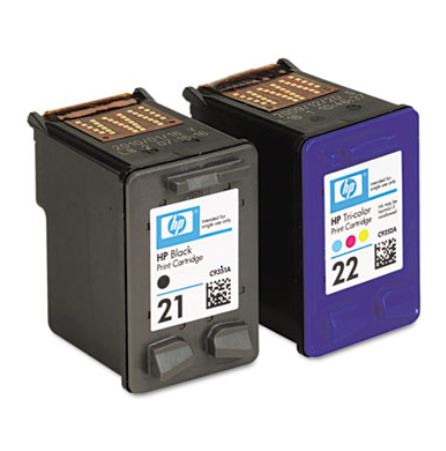 What if you could do your part in help saving the environment by recycling ink cartridges over and over? Ink cartridges are a part of an inkjet printer that contains the ink which is used to print materials. They’re made of materials that are recyclable so the actual cartridge itself can be used to make more cartridges or even other products. Furthermore, ink cartridges can also be recycled in the form of ink refilling where the cartridge itself will not undergo any significant change, but the liquid refilling will still do its part in preserving precious resources. Also, there is great debate and even confusion surrounding the use of laser printers and whether they prove to be more environmentally friendly – we will briefly touch on that subject too. Essentially, the purpose of this text is to help you to determine which ink cartridges can be recycled or refilled and what method of printing will work best for your efforts in environmental preservation while maximizing print quality.
What if you could do your part in help saving the environment by recycling ink cartridges over and over? Ink cartridges are a part of an inkjet printer that contains the ink which is used to print materials. They’re made of materials that are recyclable so the actual cartridge itself can be used to make more cartridges or even other products. Furthermore, ink cartridges can also be recycled in the form of ink refilling where the cartridge itself will not undergo any significant change, but the liquid refilling will still do its part in preserving precious resources. Also, there is great debate and even confusion surrounding the use of laser printers and whether they prove to be more environmentally friendly – we will briefly touch on that subject too. Essentially, the purpose of this text is to help you to determine which ink cartridges can be recycled or refilled and what method of printing will work best for your efforts in environmental preservation while maximizing print quality.
Ink cartridges are made of recyclable material
Ink cartridges are made of recyclable material. The problem lies with the complex design of the cartridge, which makes separating the material time-intensive and impractical. For example, electronic contact chips make it difficult to cross-use ink cartridges across different printer models and may even limit the ability to refill them with ink.
The primary type of inkjet printers uses a thermal resistor which is positioned inside the ink reservoir. The resistor is usually made of carbon-film. The ink itself is largely in part made of water. Ethylene glycol is also part of the ink solution inside the cartridge. The cartridge itself can be recycled, but most recyclers disassemble, inspect, clean, and repair the cartridge before filling it with new ink.
Spreading the information that you can recycle ink cartridges even after they have reached the maximum limit of refilling is valuable to saving space at the landfills. For example, it is estimated that approximately 350 million cartridges make their way into landfills each year. However, the recyclable material in the ink cartridges may not always be used to remanufacture new cartridges. Rather it may be burnt at high temperatures in what is known as waste to energy conversion.
From general facts, it is regarded that the average ink cartridge has a carbon footprint of 0.2 kg CO2e. This is still significantly less than the carbon footprint of a hamburger from McDonald’s, but if paper consumption and electricity used to facilitate the operation of the cartridge are taken into account, the footprint number reaches a sort of equilibrium. Many companies such as Hewlett Packard (HP) and Lexmark are leading the way to reduce their footprint through the use of up to 70% recycled plastic.
The ink in the cartridge can be refilled
The ink within the cartridges can be refilled. There has been extensive growth in the number of retailers that offer services such as ink and toner refill. There are also ink refill kits available for purchase online that can enable individuals to refill their cartridges on their own. However, the preliminary step to refilling cartridges should be to reduce our reliance on ink because we should resort to using digital versions of texts as much as possible and avoid the need for printing. Doing so aligns with the principles of reducing, reuse, and recycle. To touch note on a similar issue and give a token of advice there are fonts that reduce the consumption of ink and are known as eco-fonts.
The inherent problem with refilling ink cartridges is that it can only be done 2-3 times before the cartridge is rendered useless. As mentioned earlier, some manufacturers such as Lexmark employ an electronic chip that makes it difficult to refill ink. This can often be counter-acted with what is called a reset chip.
Ink cartridges vs. Laser Printers
If it came down to a single choice based on cartridge recyclability, laser printers would be determined to be more environmentally efficient than inkjet. Firstly, laser printers use toner, and they are less often rendered un-recyclable than inkjet cartridges. In other words, it is easier to recycle a toner over an ink cartridge.
If the consumption of electricity were a factor, laser printers would likely lose the argument. However, laser printers are still better at preserving ink and provide the benefit of better print quality as far as documents are concerned. Inkjet printers are intended for photo printing, so why use one if you are going to be printing documents most of the time? Adhering to recycled paper can also reduce the carbon footprint of printing.
Conclusion
In conclusion, every individual that uses ink to print materials should resort to refilling and recycling their cartridges. A simple internet search reveals an array of ink refill centers near you. Recycling depots will accept most ink and toner cartridges, or there may be a recycling program offered by the main business supplies depot in your neighborhood. You may also choose to purchase a printer or cartridges that are made from recycled content which is usually something that is mentioned on the packaging.






